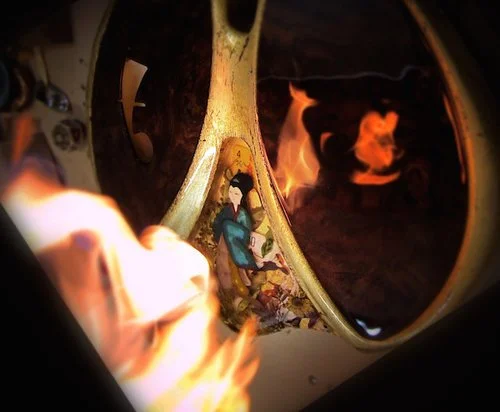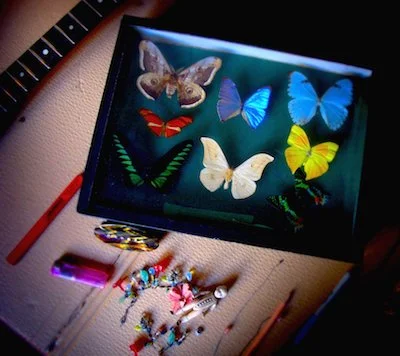“The guitar has become a cultural signpost and the sheer variety of its myriad embodiments is testament to the central role it plays in our imagination.’”
Instruments made by Michael Spalt represent the essence of the artisanal craft of guitar building while at the same time reaching across the divide into the realm of fine art. A simple tool becomes a unique piece of liveable art, while never loosing sight of its essential quality as musical instrument.
“I'm always looking forward to the moment when I can play the first few notes on a newly built instrument - to find out what it sounds like, how it plays and to welcome it to the family.”
Michael’s career as luthier now spans more than 20 years and over 600 instruments. His work today reflects the richness of his life experiences. His exposure to art started already early in childhood, since both his parents were immersed in culture and art. As a young adult he graduated from San Francisco Art Institute and later studied painting at the Academy of Applied Arts in Vienna, Austria, while working as photographer. But since his main interest has always been film he eventually moved to Los Angeles in the late 80’s, where he went to work in the film business in various capacities. Work in special effects and set construction provided him with exposure to techniques and materials which would later find use in his work as a guitar maker.
Like many of his contemporaries he started messing with guitars as a teenager, customizing and modifying guitars he could get his hands on.
Michael’s early work with traditional designs combined with doing a lot of guitar repairs gave him a solid basis in understanding materials, tone and playability — three aspects that to this day are of prime importance to him.
‘We relished the individuality of our guitars and obsessed about improving them and obtaining optimum playability. From this I took a basic understanding of guitar craft and a view towards designing guitars that don't necessarily follow the conventional mold.’
He eventually started developing his own concepts, and so began the Totemguitars. With them Michael began creating one-of-a-kind guitars in what would later become his signature-style collage art.
“I believe humans need authenticity, they crave it, even if they may not be aware of this. In today’s world, where so little is authentic and real, our feeling for what authenticity actually consists of is difficult to discern sometimes. And in its place often things that are made to look like “real” things substitute — and ironic example is the whole “relic” boom. Buying something new that is made to look old and well-played speaks to that. You’re buying fake history and fake authenticity…”
This philosophy is at the core of all of Michael’s work. A lot of what he uses are found old materials, from old shops, flea markets, flotsam from the beach, detritus from the street, or wood left overs from his workshop. All things that have been discarded, that have a history, and in this are much more interesting and valuable than new things which still have to acquire depth and spirit, which are still “flat".
These old things may have been thrown away, considered to have lost their value and function, but they have acquired an identity during their journey. They have “lived”. That is what Michael looks and then in his work he imbues his pieces with emotion and aims to evoke feelings in the beholder (sometimes they can be a bit creepy, but that is a true response and real).
The process of assembling the objects, of working with the resin, is actually quite alchemical - it involves fire, meditation, and thus the transformation of the energies contained in the individual objects, weaving their charge into a new context. Giving these things a new purpose, Michael recombines them into a new matrix. On some level it’s akin to an exorcism, freeing the objects from the ghosts of the past, letting a new individual emerge. He does not try and negate what they have lived through, they still bear the marks and scuffs of an authentic existence; indeed, that is what makes them so special and unique. They are simply reborn in the totality of the new story of the instrument.
As the instrument is played, a new charge will be built up; as it ages, it will acquire a new identity. Guitars can change quite a bit as they are played by various musicians throughout their history - it’s an interplay between the inspiration and the tone the instrument provides and the music that is created on it. It’s the reason Michael loves his job so much, because having finished the instrument, the blank canvas, so to speak, he knows it is just starting on a journey of its own, and what comes out often is a delightful surprise!
“There is a history attached to objects, people have used them, loved them, discarded them; that history is what makes them special, it confers authenticity. I believe that we need to recycle things (we use sustainably harvested or reclaimed timber a lot), and part of my attraction to found objects is the reclamation of their value beyond their immediate usefulness. I look for the poetry of objects, to weave them into my pieces and let them tell their story.”
Never one confined to one style or direction Michael always experimented with other shapes and designs. The Spalt Hybrids so took a very different path, embodying Michael’s sculptural approach to building while being stripped down to the ergonomic essentials.
Encouraged also through collaborations like ‘Guitars - 9 different tones you have never seen’ (Tokyo Art Fair, 2019) and ‘Projects of Three’ (with Adriano Sergio and Ulrich Teuffel) he continues to push and blur the boundaries between art and craft even further. Be it one-of-a-kind instruments or unique art pieces incorporating the instrument in a larger installation his work is proof that aesthetics and function can coexist successfully, providing inspiration and joy to the player as well as to the beholder.



